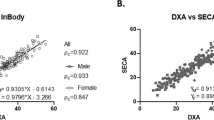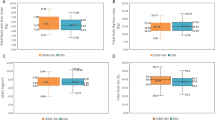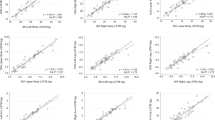Abstract
Background/Objectives:
To compare single estimations of fat-free mass (FFM) and to track FFM using single-frequency bioelectrical impedance analysis (BIA) and dual-energy X-ray absorptiometry (DXA) compared with a four-compartment (4C) model in healthy elderly Americans.
Subjects/Methods:
Thirty-four men and thirty-eight women (Caucasian, ⩾65 years) were included in the study. Subjects participated in either the control group or the exercise group. All testing and training took place during the 21-week investigation. Body composition assessments using nine BIA equations, DXA and a 4C model were performed during weeks 1, 12 and 24 of the study.
Results:
Single estimations for DXA and BIA produced high r values (0.79–0.95) and low standard error of estimate values (1.62–3.3 kg), producing subjective ratings of ‘ideal’ for men and ‘excellent’ for women. Both DXA and two BIA equations revealed the same significance when comparing groups and times with the 4C model. Individual accuracy for tracking changes was similar among BIA equations and DXA compared with the 4C model, with a total agreement of 25% for BIA and 27% for DXA compared with the 4C model.
Conclusions:
The current data in combination with the reliability errors for both BIA and DXA FFM estimations suggest that individual results should be interpreted with caution if FFM changes are <5 kg. However, DXA and BIA are both valid methods that can be used interchangeably to estimate FFM at a single time point or for tracking changes in FFM in small groups (15–22) of healthy American older adults.
This is a preview of subscription content, access via your institution
Access options
Subscribe to this journal
Receive 12 print issues and online access
$259.00 per year
only $21.58 per issue
Buy this article
- Purchase on Springer Link
- Instant access to full article PDF
Prices may be subject to local taxes which are calculated during checkout


Similar content being viewed by others
References
Hamerman D . Toward an understanding of frailty. Ann Intern Med 1999; 130: 945–950.
Census UBot. Special Tabulations on Aging-Extensive Data on Mobility and Self-Care. US Bureau of the Census: Washington, DC, 1994.
Lipsitz LA, Nakajima I, Gagnon M, Hirayama T, Connelly CM, Izumo H et al. Muscle strength and fall rates among residents of Japanese and American nursing homes: an International Cross-Cultural Study. J Am Geriatr Soc 1994; 42: 953–959.
Moon JR, Eckerson JM, Tobkin SE, Smith AE, Lockwood CM, Walter AA et al. Estimating body fat in NCAA Division I female athletes: a five-compartment model validation of laboratory methods. Eur J Appl Physiol 2009; 105: 119–130.
Wang ZM, Deurenberg P, Guo SS, Pietrobelli A, Wang J, Pierson RN et al. Six-compartment body composition model: inter-method comparisons of total body fat measurement. Int J Obes Relat Metab Disord 1998; 22: 329–337.
Evans EM, Saunders MJ, Spano MA, Arngrimsson SA, Lewis RD, Cureton KJ . Body-composition changes with diet and exercise in obese women: a comparison of estimates from clinical methods and a 4-component model. Am J Clin Nutr 1999; 70: 5–12.
Silva AM, Wang J, Pierson RN, Wang Z, Spivack J, Allison DB et al. Extracellular water across the adult lifespan: reference values for adults. Physiol Meas 2007; 28: 489–502.
Visser M, Gallagher D, Deurenberg P, Wang J, Pierson RN, Heymsfield SB . Density of fat-free body mass: relationship with race, age, and level of body fatness. Am J Physiol 1997; 272 (5 Part 1), E781–E787.
Heyward VH, Wagner DR Applied Body Composition Assessments. Human Kinetics: Champaign, IL, 2004.
Provyn S, Clarys JP, Wallace J, Scafoglieri A, Reilly T . Quality control, accuracy, and prediction capacity of dual energy X-ray absorptiometry variables and data acquisition. J Physiol Anthropol 2008; 27: 317–323.
Schneider P . Unreliable in the individual case. Deutsches Arzteblatt International 2009; 106: 39 author reply 39–40.
Clasey JL, Kanaley JA, Wideman L, Heymsfield SB, Teates CD, Gutgesell ME et al. Validity of methods of body composition assessment in young and older men and women. J Appl Physiol 1999; 86: 1728–1738.
Lohman TG, Harris M, Teixeira PJ, Weiss L . Assessing body composition and changes in body composition. Another look at dual-energy X-ray absorptiometry. Ann N Y Acad Sci 2000; 904: 45–54.
Janssen I, Heymsfield SB, Ross R . Low relative skeletal muscle mass (sarcopenia) in older persons is associated with functional impairment and physical disability. J Am Geriatr Soc 2002; 50: 889–896.
Armstrong LE, Maresh CM, Castellani JW, Bergeron MF, Kenefick RW, LaGasse KE et al. Urinary indices of hydration status. Int J Sport Nutr 1994; 4: 265–279.
Armstrong LE, Soto JA, Hacker FT, Casa DJ, Kavouras SA, Maresh CM . Urinary indices during dehydration, exercise, and rehydration. Int J Sport Nutr 1998; 8: 345–355.
Moon JR, Smith AE, Tobkin SE, Lockwood CM, Kendall KL, Graef JL et al. Total body water changes after an exercise intervention tracked using bioimpedance spectroscopy: a deuterium oxide comparison. Clin Nutr 2009; 28: 516–525.
Moon JR, Tobkin SE, Roberts MD, Dalbo VJ, Kerksick CM, Bemben MG et al. Total body water estimations in healthy men and women using bioimpedance spectroscopy: a deuterium oxide comparison. Nutr Metab (Lond) 2008; 5: 7.
Heymsfield SB, Wang J, Heshka S, Kehayias JJ, Pierson RN . Dual-photon absorptiometry: comparison of bone mineral and soft tissue mass measurements in vivo with established methods. Am J Clin Nutr 1989; 49: 1283–1289.
Wang Z, Pi-Sunyer FX, Kotler DP, Wielopolski L, Withers RT, Pierson RN et al. Multicomponent methods: evaluation of new and traditional soft tissue mineral models by in vivo neutron activation analysis. Am J Clin Nutr 2002; 76: 968–974.
Minderico CS, Silva AM, Keller K, Branco TL, Martins SS, Palmeira AL et al. Usefulness of different techniques for measuring body composition changes during weight loss in overweight and obese women. Br J Nutr 2008; 99: 432–441.
Moon JR, Tobkin SE, Smith AE, Lockwood CM, Walter AA, Cramer JT et al. Anthropometric estimations of percent body fat in NCAA division I female athletes: a 4-compartment model validation. J Strength Cond Res 2009; 23: 1068–1076.
Moon JR, Tobkin SE, Smith AE, Roberts MD, Ryan ED, Dalbo VJ et al. Percent body fat estimations in college men using field and laboratory methods: A three-compartment model approach. Dyn Med 2008; 7: 7.
Yee AJ, Fuerst T, Salamone L, Visser M, Dockrell M, Van Loan M et al. Calibration and validation of an air-displacement plethysmography method for estimating percentage body fat in an elderly population: a comparison among compartmental models. Am J Clin Nutr 2001; 74: 637–642.
Moon JR, Stout JR, Smith AE, Tobkin SE, Lockwood CM, Kendall KL et al. Reproducibility and validity of bioimpedance spectroscopy for tracking changes in total body water: implications for repeated measurements. Br J Nutr 2010; 104: 1384–1394.
Wang Z, Shen W, Withers RT, Heymsfield SB . Multicomponent molecular-level models of body composition analysis. In: Heymsfield SB, Lohman TG, Wang Z, Going SB (eds). Human Body Composition 2nd edn. Human Kinetics: Champaign, IL, 2005, pp 163–176.
Silva AM, Minderico CS, Teixeira PJ, Pietrobelli A, Sardinha LB . Body fat measurement in adolescent athletes: multicompartment molecular model comparison. Eur J Clin Nutr 2006; 60: 955–964.
Withers RT, LaForgia J, Pillans RK, Shipp NJ, Chatterton BE, Schultz CG et al. Comparisons of two-, three-, and four-compartment models of body composition analysis in men and women. J Appl Physiol 1998; 85: 238–245.
Bland JM, Altman DG . Statistical methods for assessing agreement between two methods of clinical measurement. Lancet 1986; 1: 307–310.
Brozek J, Grande F, Anderson JT, Keys A . Densitometric analysis of body composition: revision of some quantitative assumptions. Ann N Y Acad Sci 1963; 110: 113–140.
Lukaski HC, Bolonchuk WW (eds) Theory and Validation of the Tetrapolar Bioelectrical Impedance Method to Assess Human Body Composition. Institute of Physical Science and Medicine: London, 1987.
Deurenberg P, van der Kooy K, Hautvast JG . The assessment of the body composition in the elderly by densitometry, anthropometry and bioelectrical impedance. Basic Life Sci 1990; 55: 391–393.
Deurenberg P, van der Kooij K, Evers P, Hulshof T . Assessment of body composition by bioelectrical impedance in a population aged greater than 60 y. Am J Clin Nutr 1990; 51: 3–6.
Baumgartner RN, Heymsfield SB, Lichtman S, Wang J, Pierson RN . Body composition in elderly people: effect of criterion estimates on predictive equations. Am J Clin Nutr 1991; 53: 1345–1353.
Kyle UG, Genton L, Karsegard L, Slosman DO, Pichard C . Single prediction equation for bioelectrical impedance analysis in adults aged 20--94 years. Nutrition 2001; 17: 248–253.
Dey DK, Bosaeus I, Lissner L, Steen B . Body composition estimated by bioelectrical impedance in the Swedish elderly. Development of population-based prediction equation and reference values of fat-free mass and body fat for 70- and 75-y olds. Eur J Clin Nutr 2003; 57: 909–916.
Williams DP, Going SB, Milliken LA, Hall MC, Lohman TG . Practical techniques for assessing body composition in middle-aged and older adults. Med Sci Sports Exerc 1995; 27: 776–783.
Roubenoff R, Baumgartner RN, Harris TB, Dallal GE, Hannan MT, Economos CD et al. Application of bioelectrical impedance analysis to elderly populations. J Gerontol 1997; 52: M129–M136.
Acknowledgements
We thank all the subjects who participated in this investigation. This project was funded by Abbott Nutrition. ImpediMed Limited supplied the electrodes and BIA device used in this investigation. Publication of this article was supported by a grant from seca Gmbh & Co. KG, Hamburg, Germany.
Author information
Authors and Affiliations
Corresponding author
Ethics declarations
Competing interests
JRM is Research Institute Director at MusclePharm Corporation, but the corporation was not involved in the submission. JRS has received consulting fees and grant support from Abbott Nutrition. JTC is a paid consultant for Abbott Nutrition, Vital Pharmaceuticals Inc., and has served as an expert witness for Vital Pharmaceuticals. JTC has also received lecture fees from General Nutrition Center and grant support from Rock Creek Pharmaceuticals, Abbott Nutrition and General Nutrition Center. JTC receives royalties from Holocomb Hathaway for a coauthored book. The remaining authors declare no conflict of interest.
Rights and permissions
About this article
Cite this article
Moon, J., Stout, J., Smith-Ryan, A. et al. Tracking fat-free mass changes in elderly men and women using single-frequency bioimpedance and dual-energy X-ray absorptiometry: a four-compartment model comparison. Eur J Clin Nutr 67 (Suppl 1), S40–S46 (2013). https://doi.org/10.1038/ejcn.2012.163
Published:
Issue Date:
DOI: https://doi.org/10.1038/ejcn.2012.163
Keywords
This article is cited by
-
Imaging modalities for diagnosis and monitoring of cancer cachexia
EJNMMI Research (2021)
-
Association between patient-reported outcomes and exercise test outcomes in patients with COPD before and after pulmonary rehabilitation
Health and Quality of Life Outcomes (2020)
-
Reference values for body composition and associations with blood pressure in Kenyan adults aged ≥50 years old
European Journal of Clinical Nutrition (2019)
-
Adult individuals with congenital, untreated, severe isolated growth hormone deficiency have satisfactory muscular function
Endocrine (2019)
-
Age-Related Differences in the Predictability of Fast Gait Speed with Absolute and Rapid Squat Strength
Journal of Science in Sport and Exercise (2019)



